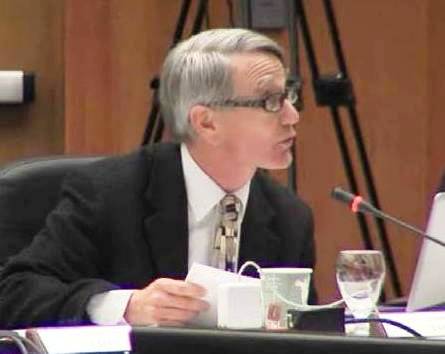April 2014
 NOTES FROM THE ACADEMIC SENATE CHAIR
NOTES FROM THE ACADEMIC SENATE CHAIR
WILLIAM JACOB
Dear colleagues,
As you know, one of my duties as Chair is to offer remarks at each Regents’ meeting. I’ve used this forum to introduce and explain some of the topics that are always important to the Senate. In the fall, I spoke about the critical role of graduate education in UC’s mission and how the UC faculty’s teaching, research, and service roles are intertwined. In January, I turned to the Senate’s rich shared governance tradition of developing initiatives to improve undergraduate education, the component of the UC mission that is most visible to California’s citizens and political leaders. I explained that the Regents have delegated to the Senate the authority to set the conditions for admission, prescribe course content, and establish degree requirements, so that every aspect of an undergraduate’s academic career at UC is in effect a Senate responsibility. At the March meeting, I talked about research.
My not-so-hidden agenda is to provide a principled foundation for the University’s engagement with California legislators as they enter the national conversation about the value of higher education. A major element in this conversation is accountability metrics, and our State legislature has proposed new “performance measures” for the University. The metrics relate to such indicators as time-to-degree, the university’s relationship to K-12, access and diversity, and transfer. As the University’s faculty, we must join this conversation by reasserting the importance of public values and emphasizing the strategies already tested and found to work.
TIME TO DEGREE
Over the past 15 years, UC’s four-year graduation rate has increased from 45% to 60%, and the two-year rate for transfers has grown from 30% to 50%. These changes are partly the result of increased selectivity in admissions, but they also result from multiple collaborations between the Senate and the administration. Jointly, we developed admission requirements that identify students who can succeed; established requirements and academic support systems for adequate progress; ensured that prerequisites are based on realistic assessments of what students need to know in order to succeed at the next level; and provided access to required classes, including in summer sessions. These projects constitute the regular workload of divisional Senate admissions committees and undergraduate councils, groups who need to inform our future efforts.
I hope that Senate colleagues will continue to insist that the college experience should not necessarily follow a straight and predictable path, and that we must preserve opportunities for students to study a broad array of subjects, change majors, and take extra time to realize their academic passions. A century ago, the nation took a great leap forward by making high school education a basic goal for all. But perceived “workforce needs” placed many low-income students into vocational programs, circumventing social mobility by limiting what they were invited to learn. Today, higher education will face a similar problem if we narrow the curriculum to speed more students through prerequisites. Expectations for increased graduation rates must be flexible and allow for a responsible spread—not a single number.
ACCESS AND DIVERSITY
Over the past decade, the Senate has led a series of initiatives to update UC’s admissions policies and processes in order to move the university away from the evaluation of applicants by grades and test scores alone to holistic review, which considers multiple aspects of preparation. The Board of Admissions and Relations with Schools has brought the Regents three major initiatives: the 14 comprehensive review criteria that require campuses to judge an applicant’s accomplishments in the context of opportunity; the restructured eligibility policy that increases from 4% to 9% the pool of students in each California high school guaranteed admission; and the expectation that all UC applications receive a holistic review.
Each initiative emerged from the Senate after a process of sustained deliberation and engagement with the administration. Each is based on the premise that in selecting students to admit to UC we must use every possible mechanism to identify talent. Today, UC enrolls more first generation and Pell grant students than any selective public or private institution in the nation by a large margin. As we continue our efforts to increase diversity, we must recognize that much of our progress could not be sustained if we reverted to the formulaic, numbers-driven eligibility and admissions processes of the past.

K-12
Most American universities have admission requirements similar to UC’s, but no other system regularly reviews high school courses to ensure they meet preparation standards. Now, a faculty-led effort has made California the first state to align explicitly its expectations for postsecondary education preparation with the Common Core State Standards in Mathematics and Language Arts. These will provide greater depth in student preparation and reflect a national vision of college and career readiness. The Intersegmental Committee of Academic Senates (ICAS) has also incorporated these new standards into the “a-g” requirements for UC and CSU admission, and into a joint statement of competencies in mathematics expected of entering freshmen. But these projects will take time to perfect, and a rushed set of accountability metrics that force us to move students through the systems quickly could derail the progress we have made.
TRANSFER AND ARTICULATION
The legislature is taking a greater interest in transfer admission, and we are hearing more about course articulation (the process by which a specific course at one campus is recognized as equivalent to a course at another). California’s three segments of higher education are decades ahead of the nation in this area. Early this year, the Western Interstate Commission on Higher Education (WICHE) was in the limelight for a moment as it announced a “passport” project that will allow students to transfer three general education courses across institutions in four states. This is an important accomplishment for the states involved, but I note that California did the same thing 20 years ago – but better – when the academic senates of the three segments, working together through ICAS, created the Intersegmental General Education Transfer Curriculum (IGETC). The senates work collaboratively to keep IGETC up to date, and last year added an alternative version of IGETC for students planning to major in STEM fields. The California legislature named IGETC one of the two general education options for the SB 1440 Associate Degrees for Transfer. The WICHE initiative is a good mechanism to improve transfer, but we should remember that it is also based on a model UC pioneered two decades ago. As the state establishes metrics for evaluating higher education, we should be sure that these accomplishments are recognized.
As we review our work in undergraduate education, especially as improving economic circumstances provide more support for innovation, we should not forget what has already worked. We must move forward deliberately, in a way that is informed by our past successes, not hastily or reactively. The Academic Senate has learned what works through decades of collaboration with the administration and with our colleagues in the other segments. These insights need to be part of the renewed public conversation about the role and direction of California higher education.
Fiat Lux, Bill
